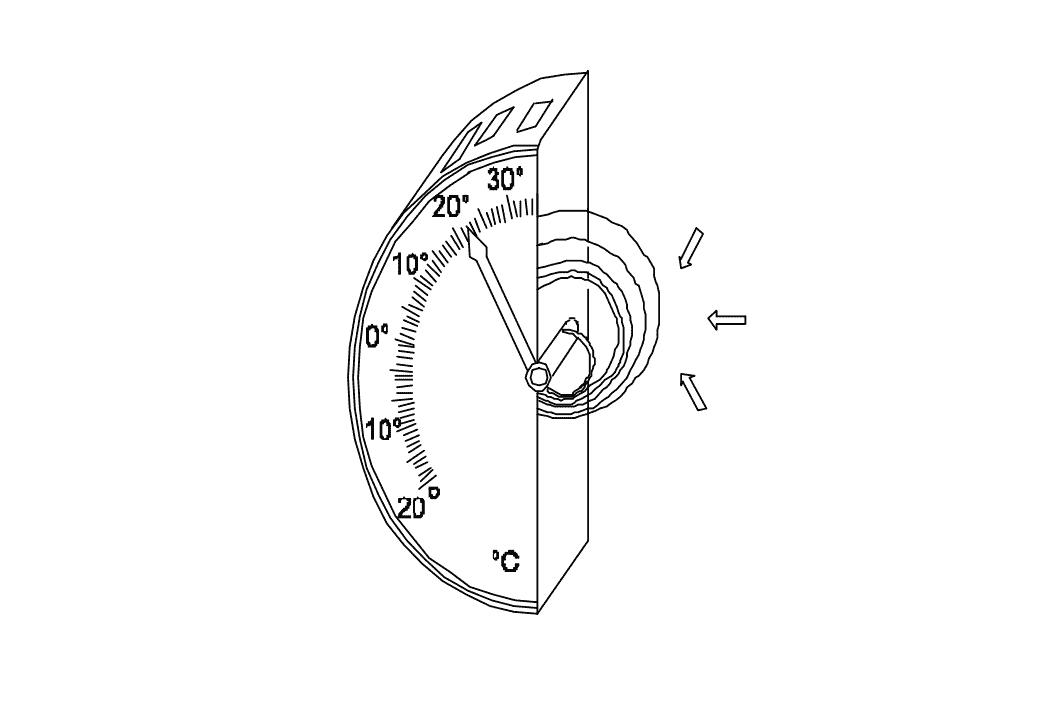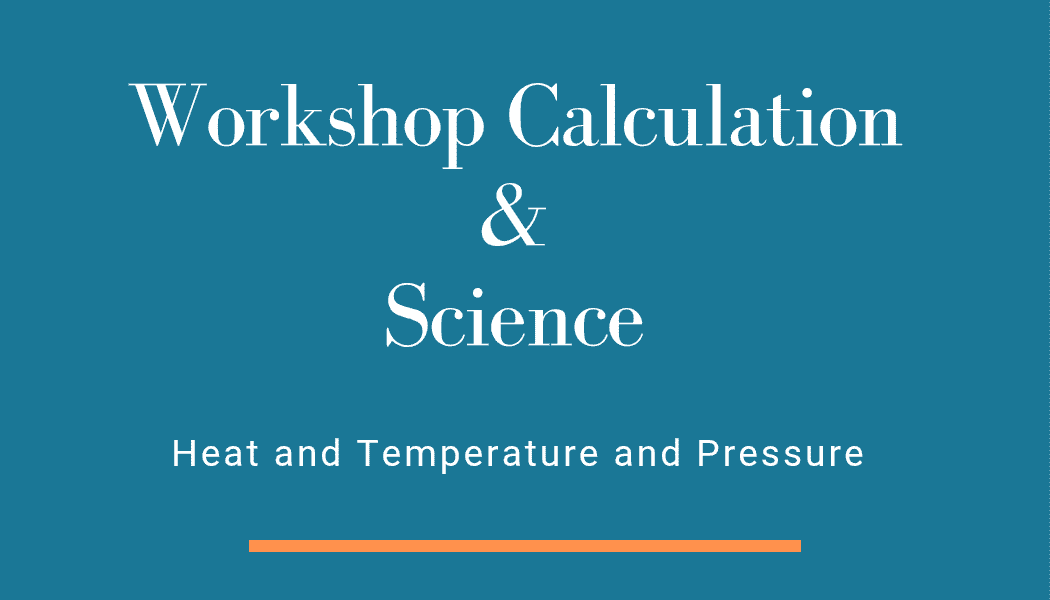Heat and Temperature and Pressure
Workshop Calculation and Science, Module-6
Q1: Which refers the temperature?
- It is a form of energy
- It tells the state of heat
- It tells specific heat of substance
- It is measured by calorie meter
Q2: What is the S.I unit of heat?
- Calorie
- Joule
- Centigrade heat unit
- British thermal unit
Q3: Which instrument is used to measure heat?
- Calorie meter
- Thermometer
- Pyrometer
- Barometer
Q4: What is the quantity of heat required to raise the temperature of 1 gram of water through 1°C is called?
- Joule
- Calorie
- British thermal unit
- Centigrade heat unit
Show Explanation
Specific heat of water is: \[ 1\ \text{cal/g}^\circ\text{C} \]
Q5: What is the value for specific heat of water?
- 4
- 3
- 2
- 1
Show Explanation
Water has a specific heat of: \[ 1\ \text{cal/g}^\circ\text{C} \]
Q6: Which type heat is the heat absorbed or given off by a substance without changing its physical state?
- Latent heat
- Sensible heat
- Specific heat
- Latent heat of steam
Show Explanation
Latent heat does not result in temperature change but only changes the state of matter.
Q7: What is the boiling point of water in fahrenheit scale?
- 212°F
- 180°F
- 112°F
- 100°F
Q8: What is the freezing point of water in kelvin scale (K)?
- 373°K
- 313°K
- 303°K
- 273°K
Show Explanation
\[ 0^\circ\text{C} = 273\ \text{K} \]
Q9: Convert 45°C (Centigrade) into °F (Fahrenheit).
- 110°F
- 111°F
- 112°F
- 113°F
Show Explanation
\[\frac{^\circ\text{C}}{5} = \frac{^\circ\text{F} - 32}{9}\]\[ °F = \left(\frac{9}{5} \times °C\right) + 32 = \left(\frac{9}{5} \times 45\right) + 32 \]\[= 113°F \]
Q10: At what temperature will Fahrenheit and centigrade thermometers give the same reading?
- -38°C
- -39°C
- -40°C
- -41°C
Show Explanation
Solving: \[ °F = \left(\frac{9}{5} \times °C\right) + 32\]\[Set, ⁰F = ⁰C\]\[ \Rightarrow °C = \left(\frac{9}{5} \times °C\right) + 32 \]\[\Rightarrow °C = -40 \]
Q11: Convert -273°C (Centigrade) into kelvin scale?
- 0°K
- 1°K
- 2°K
- 3°K
Show Explanation
\[ K = °C + 273 = -273 + 273 = 0\ K \]
Q12: What is the value in degree centigrade for 20°F?
- -6.37°C
- -6.47°C
- -6.57°C
- -6.67°C
Show Explanation
\[ °C = \frac{5}{9}(°F - 32) = \frac{5}{9}(20 - 32) = -6.67°C \]
Q13: What is the maximum temperature that can be measured by mercury thermometer?
- 400°C
- 300°C
- 200°C
- 100°C
Q14: What is the name of temperature measuring instrument?

- Vapour pressure thermometer
- Bimetalic thermometer
- Radiation pyrometer
- Thermoelectric pyrometer
Q15: Which instrument is used to measure temperatures of red hot metals up to 3000°C?
- Radiation pyrometer
- Thermoelectric pyrometer
- Bimetal thermometer
- Alcohol thermometer
Q16: Which type of heat transmission takes place through physical contact?
- Conduction
- Convection
- Radiation
- Reflection
Q17: Which kind of heat transmission takes places by up-ward flow?
- Conduction
- Convection
- Radiation
- Reflection
Q18: Which one is the radiation method of heat transmission?
- An iron rod is heated with one of its end and heat transmitted to other end
- Cold water goes to the bottom from top while on heating the water
- On heating gases, heat transmitted to surroundings
- The heat from sun travels through the space
Q19: What is called if the length of the solid expands when heated?
- Linear expansion
- Superficial expansion
- Cubical expansion
- Area expansion
Q20: What is the change in length per unit original length per degree rise in temperature is called?
- Co-efficient of friction
- Co-efficient of linear expansion
- Co-efficient of superficial expansion
- Co-efficient of cubical expansion
Q21: What is the unit of co-efficient of linear expansion?
- Number /°C
- Number /°C / meter length
- Number /°C / mm length
- Number /°C / cm length
Q22: What is term used for 2 x linear expansion?
- Co-efficient of friction
- Co-efficient of linear expansion
- Co-efficient of superficial expansion
- Co-efficient of cubical expansion
Q23: What is term called for 3 x linear expansion?
- Co-efficient of friction
- Co-efficient of linear expansion
- Co-efficient of superficial expansion
- Co-efficient of cubical expansion
Q24: What is the co-efficient of linear expansion of a rod if it is found to be 100 m long at 20°C and 100.14 m long at 100°C?
- 1.75 x 10⁻⁴ / °C
- 1.75 x 10⁻⁵ / °C
- 1.75 x 10⁻⁶ / °C
- 1.75 x 10⁻⁷ / °C
Show Explanation
\[ \alpha = \frac{\Delta L}{L \cdot \Delta T} \]\[= \frac{100.14 - 100}{100 \cdot (100 - 20)} = \frac{0.14}{8000}\]\[ = 1.75 \times 10^{-5}\ ^\circ C^{-1} \]
Q25: What is called for the amount of heat required to raise the temperature of unit mass of a substance through 1°C?
- Sensible heat
- Latent heat
- Specific heat
- Mixing of heat
Q26: How much quantity of heat is required? m = 120 litres, t₁ = 20°C, t₂ = 85°C, S = 4.2
- 32750 KJ
- 32760 KJ
- 32770 KJ
- 32780 KJ
Show Explanation
\[ Q = m \cdot S \cdot \Delta T = 120 \cdot 4.2 \cdot (85 - 20) \]\[= 120 \cdot 4.2 \cdot 65 = 32760\ \text{KJ} \]
Q27: Calculate the amount of heat required to raise the temperature of 85.5 gm of sand from 20°C to 35°C (specific heat of sand = 0.1)
- 128.25 Joules
- 125.28 Joules
- 128.26 Joules
- 126.28 Joules
Show Explanation
\[ Q = m \cdot S \cdot \Delta T \]\[= 85.5 \cdot 0.1 \cdot (35 - 20) = 128.25\ \text{J} \]
Q28: What is the specific heat of the material if we require 510 calories to raise the temperature of 170 gm of material from 50°C to 80°C?
- 0.1
- 0.01
- 1.1
- 1.11
Show Explanation
\[ S = \frac{Q}{m \cdot \Delta T} \]\[= \frac{510}{170 \cdot (80 - 50)} = \frac{510}{5100} = 0.1 \]
Q29: How much quantity of heat is required to raise the temperature of 300 grams of copper (sp.heat 0.092 cal/gram) from 25°C to 75°C in Kcal?
- 138 Kcal
- 1.38 Kcal
- 207 Kcal
- 2.07 Kcal
Show Explanation
\[ Q = m \cdot S \cdot \Delta T = 300 \cdot 0.092 \cdot (75 - 25) \]\[= 300 \cdot 0.092 \cdot 50 = 1.38\ \text{Kcal} \]
Q30: How much heat is absorbed by a copper ingot weighing 400 Kg is heated from 40°C to 72°C for the purpose of forging? (sp.heat of copper is 0.09)
- 1521 Kcal
- 1251 Kcal
- 1152 Kcal
- 1215 Kcal
Show Explanation
\[ Q = 400000 \cdot 0.09 \cdot (72 - 40) \]\[= 400 \cdot 0.09 \cdot 32 = 1152\ \text{Kcal} \]
Q31: What is called for the materials that restricts heat flow by radiation, conduction and convection?
- Conductors
- Insulators
- Ferrous
- Non-ferrous
Q32: Which one is heat insulator?
- Thermocole
- Copper
- Brass
- Aluminium
Q33: Which one has the highest thermal conductivity?
- Solid ice
- Melting ice
- Water
- Steam
Q34: Which one of the following is not a property of heat insulating material?
- Low conductivity
- Resistance to fire
- Less moisture absorption
- Ductility
Q35: Which insulating material is most widely used in refrigerators?
- Thermocole
- Polyurethane
- Glass wool
- Cork sheet
Q36: Which one is a poor heat insulator?
- Glass
- Cork
- Rubber
- Saw dust
Q37: What is known for the temperature at which any solid melts into liquid?
- Boiling point
- Melting point
- Latent heat of fusion
- Latent heat of vaporisation
Q38: What is the melting point of aluminium?
- 660°C
- 680°C
- 670°C
- 620°C
Q39: What is the boiling point of aluminium?
- 1897°C
- 2519°C
- 2469°C
- 660°C
Q40: What is the boiling point of water?
- 0°C
- 32°C
- 100°C
- 212°C
Q41: What is the melting point of mercury?
- -357°C
- -209°C
- -7.1°C
- -38.72°C
Q42: What is the boiling point of mercury?
- 357°C
- 280°C
- 759°C
- 767°C
Q43: What is the ratio of force (or) thrust per unit area?
- Work
- Power
- Pressure
- Energy
Show Explanation
\[ \text{Pressure} = \frac{\text{Force}}{\text{Area}} \]
Q44: What is the equivalent pascal value for 1 bar?
- 10⁵ pascal
- 10⁷ pascal
- 10³ pascal
- 10⁹ pascal
Show Explanation
\[ 1\ \text{bar} = 100{,}000\ \text{Pa} = 10^5\ \text{Pa} \]
Q45: What is the SI unit of pressure?
- Joule
- Pascal
- Bar
- Newton
Show Explanation
\[ \text{Pascal (Pa)} = \frac{\text{N}}{\text{m}^2} \]
